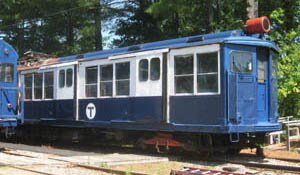
- Builder
- Pullman Car Co.
- Description
- #2 East Boston, Semi-permanently coupled together
- Secondary Use
- None
- Type
- Rapid Transit Cars
- Year
- 1924
- Retired from Service
- 1987
- Acquired by the Museum
- 1987
- Sponsor/Manager
- None
Massachusetts Bay Transportation Authority 0546 and 0547
From Boston, Massachusetts
History
In 1905, the Boston Elevated Railway (BERy) opened the East Boston Tunnel for streetcars, connecting Maverick Square with downtown Boston. To handle growing traffic, the BERy converted the tunnel to rapid transit operation in 1924. The Pullman Car Company built a fleet of new cars for the line. Forty cars were delivered in 1923 (Nos. 0500 – 0539, termed No. 1 cars) followed by 8 more in 1924 (Nos. 0540 – 0547, termed No. 2 cars). (All Boston rapid transit cars have a “0” in front of their numbers to distinguish them from streetcars.) The cars for the new line were similar to the center-entrance streetcars they replaced, using the same control and motors, with Taylor trucks for a better ride. The carbodies were smaller copies of the Cambridge Tunnel cars with three doors per side for faster loading and unloading. Each car had controls at only one end, and the blind ends were linked by drawbars without couplers. To save space in the relatively small cars, one car in the pair carried electrical equipment and the other car carried the air brake equipment. They were the first married pair rapid transit cars in the U. S. Because of the tight clearances in the former streetcar tunnel, these cars were among the smallest rapid transit cars in the United States.
The Metropolitan Transit Authority took over operation of the BERy in 1947. Starting in 1951, the MTA equipped the East Boston cars with pantographs and roof headlights for use on the new Revere Extension. The cars retained third rail shoes for operation in the tunnel. Motors and control were upgraded, and brighter lighting was installed. The MTA painted the East Boston cars two-tone gray with an orange stripe instead of the prior dark green. The MTA extended the line to Wonderland in 1954, using the former Boston, Revere Beach & Lynn Railroad right-of-way. The Massachusetts Bay Transportation Authority acquired the MTA in 1964. The MBTA adopted a color coding scheme to identify Boston’s various transit lines; the line to Wonderland became the Blue Line. So, a second repaint job for the East Boston cars took place in 1972, when blue and white replaced the former gray. At this time, robin’s egg blue replaced the pea green in the interior, and the seats were painted dark blue. Finally, in 1979, new cars, known as “Bluebells,” began to replace the venerable No. 1 and No. 2 East Boston cars. The MBTA kept most of the old cars for eight more years as potential work cars.
In 1987, a pair of No. 1 cars, Nos. 0512 and 0513, and a pair of No. 2 cars, Nos. 0546 and 0547, came to Seashore. Seashore has done little work on Nos. 0546 and 0547.
Technical Information
- Seats: 44
- Control: PC-5 (CJ-127)
- Brakes: SMEE
- Compressor: DH-16
Trucks
- Number: 2
- Manufacturer: Taylor
- Model: TR
Motor
- Number: 4
- Manufacturer: Westinghouse
- Model: 514E
Weight and Dimensions
- Length: 47’ 3.00"
- Width: 8’ 3.00"
- Height: 13’ 2.00"
- Weight: 44000 lbs.
© 1998 - 2025 New England Electric Railway Historical Society. All Rights Reserved.